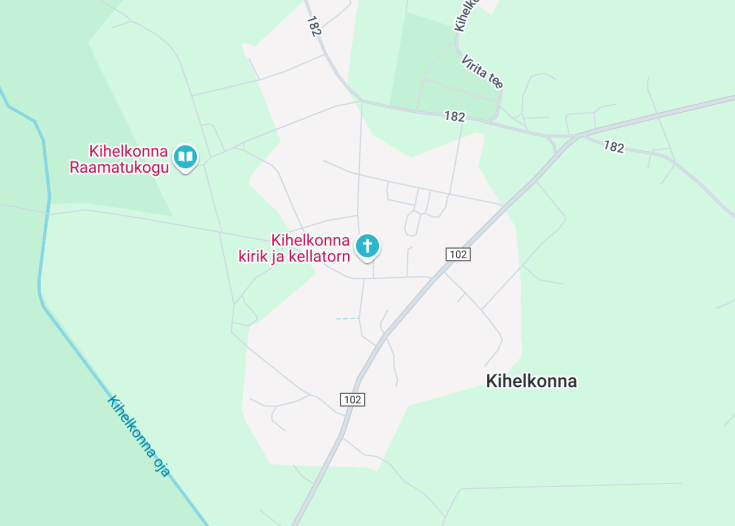Kihelkonna kirik ja kellatorn: A Timeless Gem in Kihelkonna
Located in the heart of Kihelkonna, Estonia, the Kihelkonna kirik ja kellatorn stands as a testament to the region’s rich cultural and architectural heritage. This historic church and bell tower duo offers visitors a unique glimpse into Estonia’s past, blending medieval architecture with serene natural surroundings. The church, with its intricate stonework and towering spire, serves not only as a place of worship but also as a beacon for both locals and tourists alike. The adjacent bell tower adds to the charm, its chimes echoing through the picturesque town, marking the passage of time and events. Visitors are often captivated by the peaceful ambiance, making it a perfect spot for reflection and exploration. Surrounded by lush landscapes and quaint streets, the Kihelkonna kirik ja kellatorn is a must-visit destination for those seeking to immerse themselves in Estonia’s spiritual and historical essence.
Exploring the Architectural Wonders at Kihelkonna kirik ja kellatorn
The Kihelkonna kirik ja kellatorn offers a variety of attractions that cater to history enthusiasts and casual visitors alike. Take a guided tour through the church to admire its Gothic architectural elements, including stunning stained glass windows and ornate wooden pews. The bell tower invites adventurers to climb its narrow, winding stairs for a panoramic view of Kihelkonna’s charming landscape, offering breathtaking vistas of the surrounding countryside and the Baltic Sea in the distance.
Historical Exhibits
Inside the church, visitors can explore exhibits that showcase artifacts and stories from the region’s past, providing deeper insights into the local heritage.
Community Events
The venue frequently hosts cultural events and concerts, allowing guests to experience the local traditions and the vibrant community spirit of Kihelkonna.
An Intriguing Fact About Kihelkonna kirik ja kellatorn
Did you know that the Kihelkonna kirik ja kellatorn has survived numerous historical events, including wars and natural disasters, maintaining its structural integrity and beauty over the centuries? This resilience not only reflects the architectural prowess of its builders but also symbolizes the enduring spirit of the Kihelkonna community. Each stone in the church walls holds stories of bygone eras, making it a living monument that continues to inspire and attract visitors from around the world.
Discover the Historic Charm of Kihelkonna Kirik ja Kellatorn in Kihelkonna, Estonia
Step into a world where medieval architecture meets serene landscapes at the Kihelkonna Kirik ja Kellatorn. This stunning church and its iconic bell tower are perfect for history enthusiasts, architecture lovers, and anyone seeking a peaceful retreat. Visitors can expect to be mesmerized by the intricate stonework, towering spire, and the tranquil ambiance that envelops the site. The church serves as a pivotal point on several tourist itineraries, seamlessly fitting into broader routes that explore Estonia’s rich cultural and historical tapestry. For those keen on uncovering unique insights, a professional guide can reveal little-known stories and architectural details that add depth to the visit.
The surrounding area offers picturesque views and a glimpse into the local way of life, making it an ideal stop for photographers and nature lovers alike. Whether you’re taking a leisurely stroll through the nearby countryside or exploring other historical landmarks in the vicinity, the Kihelkonna Kirik ja Kellatorn stands out as a must-visit destination that enriches your overall travel experience.
When to Visit Kihelkonna Kirik ja Kellatorn for the Best Experience
The spring and summer months are ideal for visiting Kihelkonna Kirik ja Kellatorn, as the pleasant weather enhances the beauty of the surrounding landscapes and allows for extended exploration of the site. During these seasons, the longer daylight hours provide ample time to fully appreciate the intricate details of the church and enjoy the serene environment.
Annual Bell-Ringing Festival
For a truly unique experience, plan your visit during the annual Bell-Ringing Festival. This event showcases traditional bell-ringing techniques and includes live demonstrations, music performances, and community gatherings that celebrate the cultural significance of the bell tower.
Accessibility and Limitations
While Kihelkonna Kirik ja Kellatorn is largely accessible, visitors should be aware of certain limitations to ensure a smooth and enjoyable experience.
Accessibility
The church and bell tower are accessible to individuals with mobility challenges. There are ramps and designated seating areas to accommodate wheelchair users, ensuring that everyone can enjoy the historical site comfortably.
Limitations
- Photography is restricted in certain areas of the church to preserve its interior.
- Access to the bell tower may be limited during maintenance or special religious services.
- Large groups may need to book visits in advance to manage visitor flow.
Notes to Visitors
- Dress modestly when visiting the church as it is an active place of worship.
- Respect quiet zones within the church to maintain a peaceful atmosphere.
- Check the local event calendar before visiting to avoid times when the site may be closed for private functions.
General Information
Plan your visit to Kihelkonna Kirik ja Kellatorn with all the essential details to ensure a memorable experience.
Location
Kihelkonna Kirik ja Kellatorn is nestled near the picturesque Kihelkonna Harbor, making it easily accessible from the town center. The proximity to local landmarks such as the Kihelkonna Lighthouse and the seaside promenade adds to its appeal.
Address:
Hannuse tn 2-4, Kihelkonna, 93401 Saare maakond
Visiting Information
The Kihelkonna Kirik ja Kellatorn is open to the public daily without strict closing times, allowing visitors to explore at their own pace. It is best to visit during the early morning or late afternoon to enjoy the soft natural light and avoid the midday crowds, enhancing the overall experience.
How to Reach Kihelkonna Kirik ja Kellatorn
The Kihelkonna Kirik ja Kellatorn can be conveniently accessed via various modes of transportation from the Kihelkonna town center.
Car
Driving to Kihelkonna Kirik ja Kellatorn is straightforward, with ample parking available near the church grounds. Visitors can park in the designated areas at no additional cost and enjoy a short walk to the site.
| Route |
Distance |
Travel time |
| From Kihelkonna Bus Station |
1 mile (1.6 km) |
5 minutes |
| From Kihelkonna Harbor |
0.5 miles (0.8 km) |
3 minutes |
| From Kihnu Island Ferry Terminal |
2 miles (3.2 km) |
10 minutes |
Bus
Public buses run regularly from the Kihelkonna town center to the church. The journey is quick and convenient, taking approximately 10 minutes from the central bus stop.
| Route |
Distance |
Travel time |
| From Kihelkonna Town Center |
1 mile (1.6 km) |
10 minutes |
| From Kihelkonna Harbor |
0.5 miles (0.8 km) |
7 minutes |
| From Kihnu Island Ferry Terminal |
2 miles (3.2 km) |
15 minutes |
Nearby Attractions
- Kihelkonna Lighthouse – 0.3 miles (0.5 km)
- Kihnu Island Ferry Terminal – 2 miles (3.2 km)
- Kihelkonna Harbor – 0.2 miles (0.3 km)
- Local Art Museum – 0.4 miles (0.6 km)
- Seaside Promenade – 0.5 miles (0.8 km)
- Kihelkonna Bus Station – 1 mile (1.6 km)
- Historic Town Hall – 0.6 miles (1 km)
- Kihelkonna Cultural Center – 0.7 miles (1.1 km)
- Old Mill Park – 1.2 miles (1.9 km)
- Kihelkonna Public Library – 0.8 miles (1.3 km)
- Botanical Garden – 1.5 miles (2.4 km)
- Kihelkonna Sports Complex – 1.3 miles (2.1 km)
Common Questions
What is the history of Kihelkonna Church and Bell Tower?
Kihelkonna Church, known as Kihelkonna kirik, alongside its Bell Tower (kellatorn), is one of the oldest ecclesiastical buildings in Estonia. The church’s origins date back to the 13th century, during the period of Danish rule in the region. Originally constructed as a Romanesque-style stone church, it has undergone several renovations and expansions over the centuries, reflecting various architectural influences. The Bell Tower, added in the late medieval period, served both religious and community functions, housing bells that marked time and events for the local populace. Throughout its history, Kihelkonna kirik ja kellatorn have been central to the spiritual and cultural life of Kihelkonna, surviving numerous historical events, including wars and occupations, while retaining much of their original character and significance.
What architectural style is Kihelkonna kirik ja kellatorn built in?
Kihelkonna Church and its Bell Tower exhibit a blend of architectural styles that have evolved over the centuries. The original structure of Kihelkonna kirik was built in the Romanesque style, characterized by thick stone walls, sturdy pillars, and small windows, typical of medieval ecclesiastical architecture. Over time, Gothic elements were incorporated, evident in the church’s vaulted ceilings, pointed arches, and more elaborate stone carvings. The Bell Tower complements the church with its own Gothic features, including lancet windows and decorative stonework. Additionally, later renovations introduced Baroque influences, adding ornate details and expanding the church’s interior spaces. This fusion of styles makes Kihelkonna kirik ja kellatorn a unique representation of Estonia’s architectural history, showcasing the transition from medieval simplicity to more decorative designs.
Are there any notable artworks or features inside Kihelkonna Church?
Yes, Kihelkonna Church is home to several notable artworks and architectural features that attract both worshippers and visitors alike. Inside the church, you can find: – Altarpiece: A beautifully crafted altarpiece that serves as the focal point of the sanctuary, featuring intricate wood carvings and religious iconography. – Stained Glass Windows: Elaborate stained glass windows depict various biblical scenes and saints, adding vibrant colors and storytelling elements to the interior. – Pews and Woodwork: The church contains original wooden pews and detailed woodwork, showcasing the craftsmanship of the period. – Organ: A historic pipe organ, which has been restored to maintain its original sound, is used during services and concerts. – Memorials and Plaques: Various memorials and plaques honor significant figures in the church’s history and the local community. These elements contribute to the church’s historical and artistic value, making it a noteworthy site for those interested in religious art and architecture.
What is the significance of the bell tower in Kihelkonna?
The Bell Tower of Kihelkonna, or kellatorn, holds significant historical and cultural importance within the community. Traditionally, the bell tower served multiple purposes: – Timekeeping: Bells were rung to signal daily prayers, mark the hours, and announce important events to the villagers. – Communication: In times of emergency, such as fires or invasions, the bells acted as a warning system to alert residents. – Ceremonial Role: The tower was central to religious ceremonies, weddings, funerals, and other community gatherings, reinforcing its role as a communal landmark. – Architectural Statement: The presence of a bell tower added grandeur to the church complex, symbolizing the church’s prominence and the community’s devotion. Today, the bell tower remains a cherished historical monument, representing the enduring legacy of Kihelkonna’s religious and social heritage. Its preservation allows visitors to appreciate the architectural beauty and the functional roles it played throughout the centuries.
Can visitors attend services or religious ceremonies at Kihelkonna Church?
Yes, visitors are welcome to attend services and religious ceremonies at Kihelkonna Church, provided they respect the sanctity of the space and the customs of the congregation. Services are typically held on Sundays and religious holidays, following the traditions of the local Lutheran community. Participants can experience: – Worship Services: These include hymns, prayers, sermons, and communal worship, offering insight into the local religious practices. – Special Ceremonies: Events such as weddings, baptisms, and memorial services are conducted, often accompanied by traditional music and rituals. – Concerts and Recitals: The church occasionally hosts musical performances, taking advantage of the acoustics provided by its historic architecture. Visitors are encouraged to check the church’s schedule or contact the parish office for information on service times and any potential visitor guidelines to ensure a respectful and enriching experience.
What restoration or conservation efforts have been undertaken for Kihelkonna kirik ja kellatorn?
Kihelkonna Church and Bell Tower have undergone several restoration and conservation efforts to preserve their structural integrity and historical appearance. Key projects include: – Structural Reinforcement: Addressing foundational issues and reinforcing walls to prevent deterioration caused by weathering and age. – Stone Masonry Restoration: Repairing and cleaning stone surfaces, replacing damaged stones, and preserving original carvings and inscriptions. – Roof Renovation: Restoring the roof to protect the interior from moisture and damage, including the replacement of old shingles with historically accurate materials. – Stained Glass Preservation: Cleaning, repairing, and restoring stained glass windows to maintain their vibrancy and detail. – Interior Refurbishment: Restoring pews, altarpieces, and other interior elements to their original condition while ensuring they meet modern safety standards. – Bell Tower Maintenance: Ensuring the bell tower remains structurally sound, including the preservation of the bells and the mechanisms used to ring them. These conservation efforts are typically funded by a combination of government grants, church funds, and community donations, reflecting the collective commitment to preserving Kihelkonna kirik ja kellatorn for future generations.
Are there any legends or stories associated with Kihelkonna Church and Bell Tower?
Yes, Kihelkonna Church and its Bell Tower are steeped in local legends and stories that add to their mystical allure. One popular legend involves the origin of the church’s bells. It is said that during a time of great hardship, a mysterious craftsman appeared to the villagers, forging bells that were not only beautiful but also possessed the power to ward off evil spirits and protect the community. Another tale speaks of a secret tunnel beneath the church complex, allegedly used during medieval conflicts to provide a safe passage for clergy and villagers escaping invaders. Additionally, folklore suggests that the bell tower is haunted by a benevolent spirit, believed to be a former pastor who continues to watch over the church. These stories, while not historically verified, contribute to the rich cultural tapestry of Kihelkonna and enhance the spiritual experience for visitors and locals alike.
What are the notable events in the history of Kihelkonna kirik ja kellatorn?
Kihelkonna Church and Bell Tower have been the backdrop for numerous significant events throughout their history: – Construction and Initial Dedication (13th Century): Established during the medieval period, marking the Christianization of the region under Danish influence. – Reformation Impact (16th Century): The church transitioned from Catholicism to Lutheranism, leading to iconoclasm and changes in liturgical practices. – Swedish and Russian Rule: The church endured periods of Swedish and later Russian dominance, each leaving architectural and cultural influences. – World War II and Soviet Era: Survived the turmoil of World War II and the ensuing Soviet occupation, during which religious activities were restricted but the building itself remained intact. – Restoration Projects (20th and 21st Centuries): Major restoration efforts were undertaken to preserve the church and bell tower, especially after Estonia regained independence in 1991. – Cultural Festivals and Heritage Recognition: The site became a focal point for local cultural festivals and was recognized as a protected heritage site, ensuring its preservation for future generations. These events highlight the church’s resilience and its enduring importance as a spiritual and cultural landmark in Kihelkonna.
Who were the key figures involved in the construction or decoration of Kihelkonna church?
The construction and decoration of Kihelkonna Church involved several key figures over its long history: – Medieval Master Builders: Unknown artisans and craftsmen who laid the foundation and original Romanesque structure in the 13th century. – Gothic Architects (14th-15th Century): Architects who introduced Gothic elements during renovations, enhancing the church’s verticality and ornate details. – Local Artists and Carpenters: Individuals responsible for the intricate woodwork, stained glass windows, and interior furnishings, contributing to the church’s artistic heritage. – Clergy and Patrons: Local church leaders and wealthy patrons who funded various construction projects and decorative enhancements, ensuring the church’s development and maintenance. – 20th Century Conservators: Specialists who led restoration efforts, preserving the structural and artistic integrity of both the church and the bell tower. While specific names may not be well-documented, the collaborative efforts of these builders, artists, and patrons have collectively shaped Kihelkonna kirik ja kellatorn into the historical monument it is today.
Are there any unique architectural elements or design features in Kihelkonna kirik ja kellatorn?
Kihelkonna Church and Bell Tower boast several unique architectural elements and design features that distinguish them from other ecclesiastical structures in Estonia: – Combination of Romanesque and Gothic Styles: The seamless integration of robust Romanesque elements with the lofty, ornate features of Gothic architecture creates a distinctive aesthetic. – Intricate Stone Carvings: Detailed carvings on the façade and interior, including biblical motifs, floral patterns, and symbolic figures, showcase the craftsmanship of medieval masons. – Lancet Windows: Tall, narrow windows with pointed arches, characteristic of Gothic design, allow natural light to illuminate the interior while adding vertical emphasis. – Bell Tower Design: The tower features decorative battlements and lancet windows, embodying the architectural transition from purely functional to more ornamental structures. – Vaulted Ceilings: The church’s vaulted ceilings not only provide structural strength but also enhance the acoustics, enriching the auditory experience during services and concerts. – Roof Construction: The use of traditional materials and techniques in the roof’s design preserves the historical integrity while ensuring durability. These unique features make Kihelkonna kirik ja kellatorn a remarkable example of historical architecture, attracting enthusiasts and scholars interested in medieval and Gothic design principles.
What materials were used in building Kihelkonna Church and Bell Tower?
The construction of Kihelkonna Church and its Bell Tower utilized a variety of materials that were locally sourced and typical of medieval ecclesiastical architecture: – Stone: The primary material for the church’s walls and bell tower, stone provided durability and resistance to the harsh Baltic climate. Local granite and limestone were commonly used, offering both structural integrity and aesthetic appeal. – Wood: Timber was used for the roof structure, beams, and interior furnishings such as pews and altarpieces. The wood was often sourced from nearby forests, ensuring availability and sustainability. – Brick: In some sections, especially during later renovations, bricks were incorporated for particular architectural details or structural reinforcements. – Glass: Stained glass windows were crafted from colored glass panes, held together by lead cames. These windows not only served a decorative purpose but also filled the interior with colorful light. – Metal: Iron and other metals were used for structural supports, door fittings, and the mechanisms of the bells in the tower. The bells themselves are typically cast from bronze or other metal alloys. – Mortar and Plaster: These binding materials were essential for holding the stone and brick elements together, as well as for finishing interior walls and ceilings. The combination of these materials reflects the resourcefulness and craftsmanship of the builders, ensuring that Kihelkonna kirik ja kellatorn have withstood the test of time while maintaining their historical character.
Is Kihelkonna kirik ja kellatorn recognized as a heritage or protected building?
Yes, Kihelkonna Church and its Bell Tower are officially recognized as protected heritage sites in Estonia. This designation is part of Estonia’s broader efforts to preserve its cultural and historical landmarks. As protected structures, they are subject to specific conservation guidelines aimed at maintaining their architectural integrity and historical significance. Any restoration or renovation work must comply with these regulations, ensuring that original materials and construction techniques are respected. Additionally, the site may be eligible for government grants and funding aimed at heritage preservation. This status not only safeguards the church and bell tower for future generations but also highlights their importance as cultural and historical assets within the Kihelkonna community and Estonia at large.
What role does Kihelkonna kirik ja kellatorn play in the local community today?
Today, Kihelkonna Church and Bell Tower continue to serve as vital centers for spiritual, cultural, and social activities within the local community. Their roles include: – Religious Services: Hosting regular worship services, ceremonies, and religious events that cater to the spiritual needs of residents. – Cultural Events: Serving as venues for concerts, art exhibitions, and community gatherings, leveraging their historic ambiance and acoustics. – Educational Purposes: Providing educational opportunities for visitors and locals to learn about medieval architecture, religious history, and cultural heritage through guided tours and informational programs. – Community Hub: Acting as a focal point for community discussions, meetings, and local initiatives, fostering a sense of unity and shared identity among residents. – Tourism Attraction: Drawing visitors from around Estonia and beyond, contributing to local tourism and the economy by showcasing the town’s historical and architectural treasures. By fulfilling these roles, Kihelkonna kirik ja kellatorn remain integral to the community’s daily life and cultural preservation efforts, bridging the past with the present.
How does Kihelkonna kirik ja kellatorn contribute to Estonia’s architectural heritage?
Kihelkonna Church and its Bell Tower are significant contributors to Estonia’s architectural heritage, exemplifying the country’s medieval ecclesiastical architecture and the evolution of religious buildings over time. Their contributions include: – Historical Representation: As one of the oldest stone churches in Estonia, they provide insight into the architectural styles and construction techniques of the 13th century. – Architectural Diversity: The blend of Romanesque and Gothic elements showcases the transition in architectural styles and the influence of different periods on local church design. – Preservation of Craftsmanship: The intricate stone carvings, stained glass work, and wooden interiors preserve traditional craftsmanship skills that are an essential part of Estonia’s cultural legacy. – Educational Value: They serve as valuable case studies for architects, historians, and scholars studying medieval architecture and restoration practices. – Cultural Continuity: By maintaining their original functions and adapting to contemporary needs, Kihelkonna kirik ja kellatorn embody the continuity of cultural and religious practices in Estonia. Overall, these structures not only enhance the architectural landscape of Kihelkonna but also hold a place of pride within Estonia’s national heritage, attracting attention from conservationists and enthusiasts alike.
Are there any special events or exhibitions held at Kihelkonna kirk and bell tower?
Yes, Kihelkonna Church and Bell Tower host a variety of special events and exhibitions throughout the year that highlight their historical and cultural significance: – Historical Exhibitions: Displays featuring artifacts, photographs, and documents related to the church’s history and the local community’s heritage. – Art Concerts: Musical performances, including classical and sacred music concerts, take advantage of the church’s excellent acoustics and intimate setting. – Cultural Festivals: Participation in local and national cultural festivals, where the church and bell tower serve as central venues for celebrations and gatherings. – Educational Workshops: Programs aimed at educating visitors about medieval architecture, conservation techniques, and the church’s role in the region’s history. – Seasonal Celebrations: Special services and events during religious holidays such as Christmas and Easter, often accompanied by traditional music and decorations. – Guided Tours: Regularly scheduled tours led by knowledgeable guides who provide in-depth information about the church’s architecture, art, and historical context. These events and exhibitions not only promote the preservation of Kihelkonna kirik ja kellatorn but also engage the community and visitors in appreciating their rich cultural legacy.
What are the visiting guidelines for tourists at Kihelkonna Church and Bell Tower?
When visiting Kihelkonna Church and Bell Tower, tourists should adhere to certain guidelines to ensure a respectful and enjoyable experience: – Dress Code: Visitors are encouraged to dress modestly, particularly if they plan to attend a service or ceremony. – Respect Quiet Hours: Maintain a respectful demeanor, especially during worship times and inside the church. Avoid loud conversations and unnecessary noise. – Photography: Photography is typically allowed in designated areas, but flash usage and tripods may be restricted. Always check for signage or ask for permission before taking photos. – No Smoking: Smoking is prohibited within the church and surrounding areas to preserve the sanctity and cleanliness of the site. – Guided Tours: Consider joining a guided tour to gain deeper insights into the history and architecture of the church and bell tower. Tour schedules and availability should be checked in advance. – Handling Artifacts: Do not touch or disturb any artworks, stained glass windows, or historical artifacts. They are delicate and require preservation. – Accessibility: Visitors with disabilities should check in advance regarding accessible entrances and facilities to ensure a comfortable visit. – Leave No Trace: Dispose of trash properly and avoid leaving any belongings behind to maintain the site’s cleanliness and integrity. By following these guidelines, tourists can help preserve Kihelkonna kirik ja kellatorn while enjoying their visit to this historic landmark.
HelloMondo review

"Kihelkonna kirik ja kellatorn enchants with its historic architecture and serene ambiance. A worthwhile visit for culture lovers."
Is Kihelkonna kirik ja kellatorn in Kihelkonna, Estonia Worth Visiting?
Kihelkonna kirik ja kellatorn, nestled in the heart of Kihelkonna, offers visitors a unique blend of historic architecture and cultural significance. The church, adorned with intricate designs, showcases Estonia’s rich religious heritage, while the bell tower provides panoramic views of the picturesque landscapes.
Tourists will appreciate the serene atmosphere ideal for both reflection and exploration. The well-preserved structures give a glimpse into the past, making it a perfect destination for history enthusiasts and architecture buffs alike.
Moreover, the welcoming local community enhances the visitor experience by sharing insights and stories that bring the site to life. Although it may not be as bustling as larger tourist attractions, its charm lies in its authenticity and tranquil setting.
Overall, Kihelkonna kirik ja kellatorn is a worthy destination for those seeking a meaningful and peaceful visit in Estonia.










